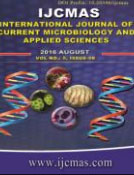


 National Academy of Agricultural Sciences (NAAS)
National Academy of Agricultural Sciences (NAAS)

|
PRINT ISSN : 2319-7692
Online ISSN : 2319-7706 Issues : 12 per year Publisher : Excellent Publishers Email : editorijcmas@gmail.com / submit@ijcmas.com Editor-in-chief: Dr.M.Prakash Index Copernicus ICV 2018: 95.39 NAAS RATING 2020: 5.38 |
Abnormal vaginal discharge is the most common gynaecological symptom in reproductive age group(15-45 years). It’s prevalence in India is 30%. Aetiological agent of vaginitis can be bacterial, fungal or parasitic. It causes significant morbidity like pelvic inflammatory disease(PID), infertility, pregnancy loss, preterm labour, increased risk of other STDs to mention a few. Hence, the present study was undertaken to unravel the specific etiological agents and their sensitivity pattern. Totally, 200 high vaginal swabs from clinically suspected vaginitis cases were subjected to saline-wet mount, pH-estimation, Gram stain, Methyl-violet stain, KOH-mount and whiff/amine test. Samples were cultured aerobically. Organisms were identified with their antibiotic sensitivity pattern. Most common cause was Aerobic-vaginitis(32%). Commonest organisms were E.coli, P.aeruginosa and S.aureus. Many were sensitive to amikacin except for P.aeruginosa which were sensitive to imipenem and colistin. Vulvovaginal-candidiasis, Bacterial-vaginosis and Trichomoniasis were seen in14.5%, 14% and 6.5% of our cases respectively. All vaginal discharge cases should be considered for rapid microbiological examination like Saline-wet mount, Gram stain, KOH-mount and Whiff test. The diagnosis should be confirmed by identification and it’s susceptibility pattern for specific treatment to avoid above complications.
 |
 |
 |
 |
 |